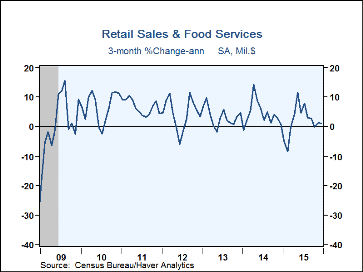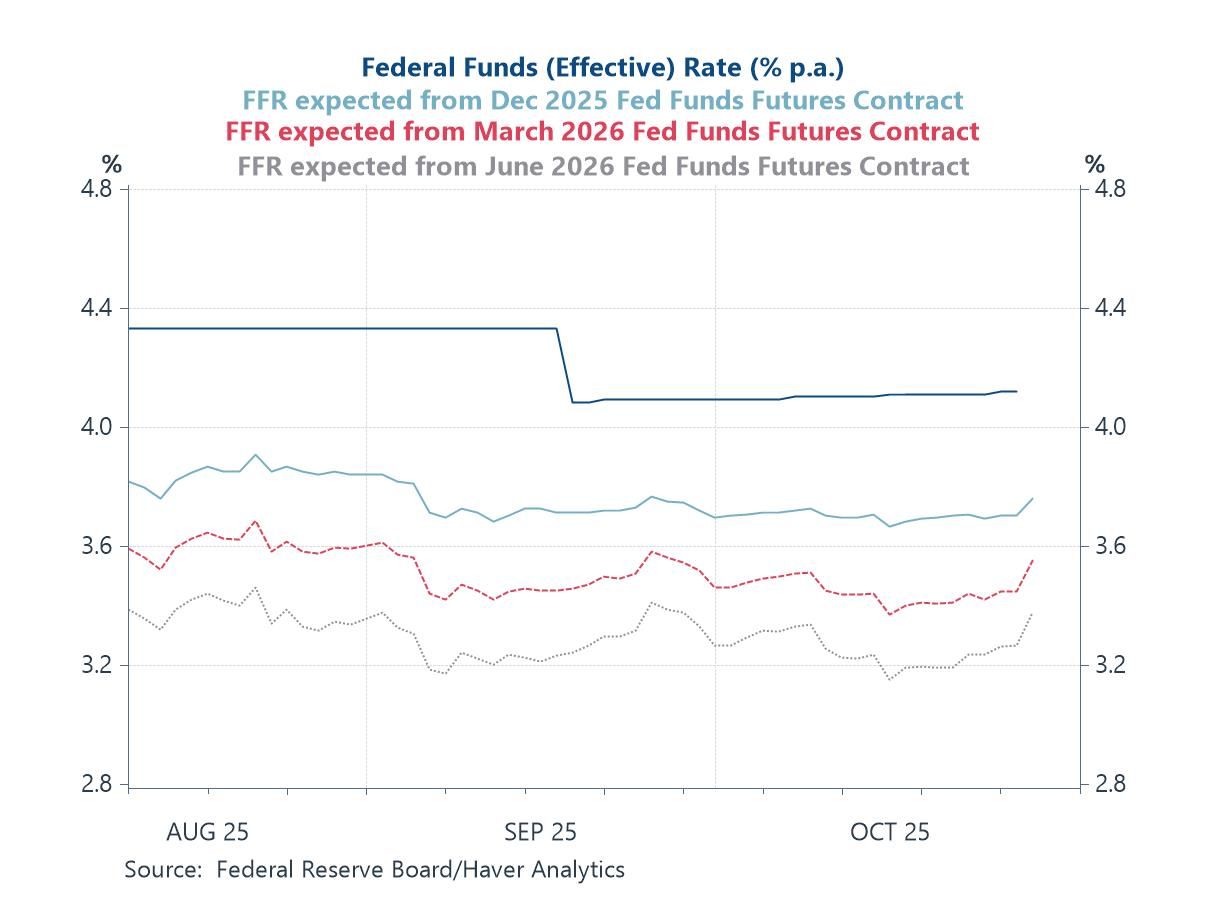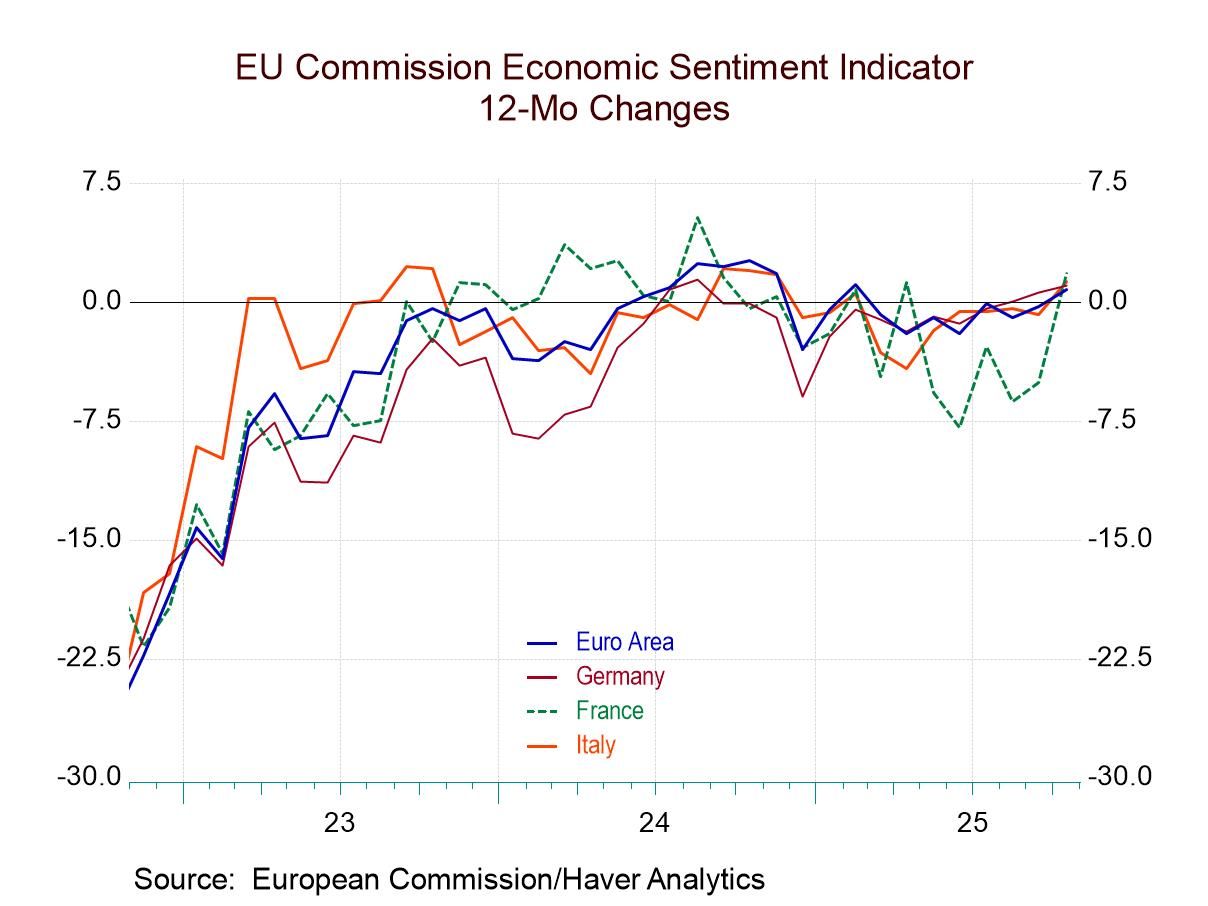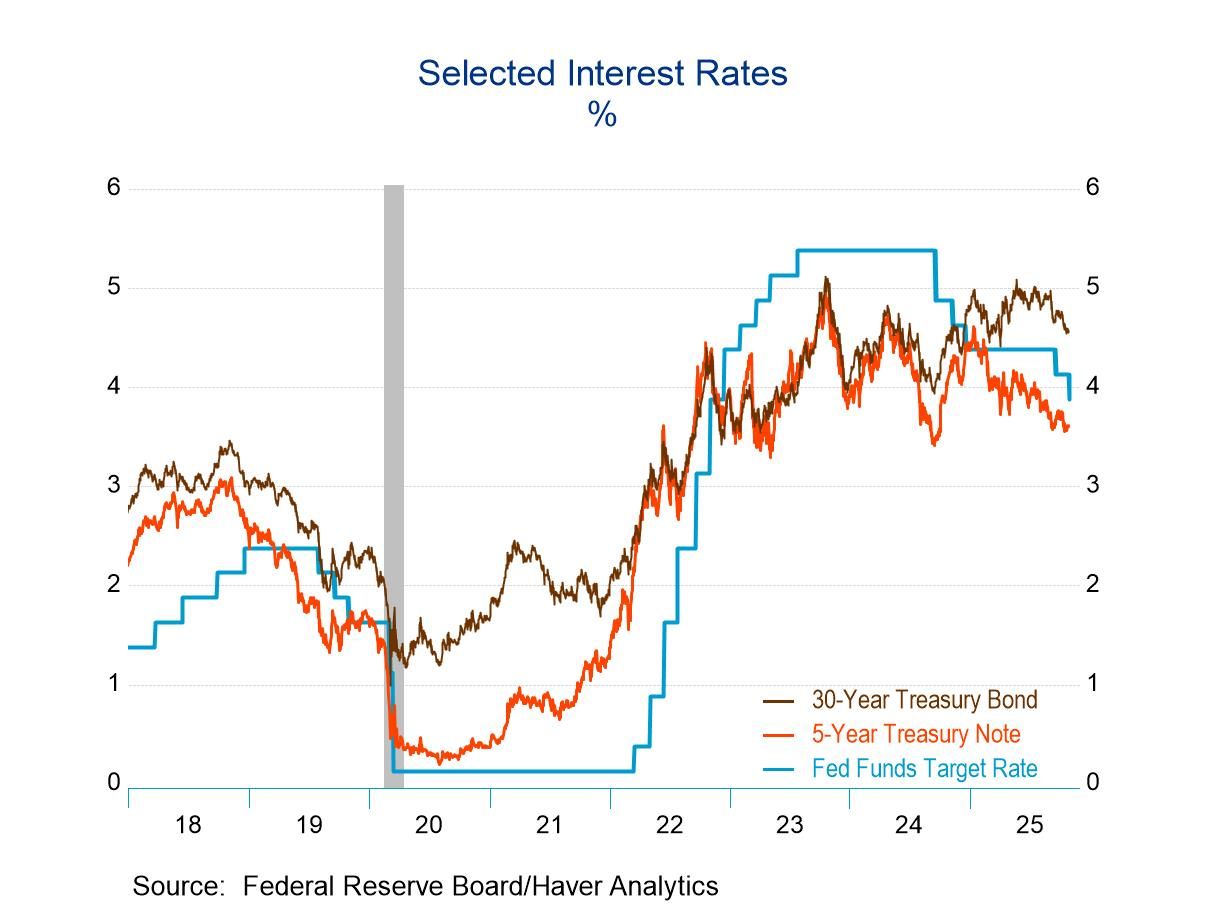 Global| Jan 15 2016
Global| Jan 15 2016U.S. Retail Sales Ease; Weakness Is Broad-Based
by:Tom Moeller
|in:Economy in Brief
Summary
Consumers reined in their spending for the holiday season. Purchases at retail stores and restaurants eased 0.1% during December (+2.8% y/y) following a 0.4% November rise, revised from 0.2%. For all of last year, sales advanced 2.1%, [...]
Consumers reined in their spending for the holiday season. Purchases at retail stores and restaurants eased 0.1% during December (+2.8% y/y) following a 0.4% November rise, revised from 0.2%. For all of last year, sales advanced 2.1%, the weakest increase since a decline in 2009. The latest rise disappointed expectations for a 0.1% rise in the Action Economics Forecast Survey.
An unchanged dollar value of motor vehicle sales compared to a 4.6% decline in unit vehicle sales. Retail sales elsewhere, however, were weak as they also posted a 0.1% dip. Lower gasoline prices also restrained the dollar value of spending with a 1.1% drop (-14.4% y/y), the sixth consecutive monthly fall. Overall retail sales excluding autos and gasoline as well as building materials and restaurants declined 0.3% (+2.8% y/y) after a 0.5% rise.
Sales in most discretionary spending categories weakened, led by a 1.0% decline in general merchandise store sales which also were unchanged y/y. It was the third monthly decline in a row. Clothing & accessory store sales fell 0.9% (+1.4% y/y), the fourth decline in five months. Electronics & accessory store sales eased 0.3% (-3.5% y/y), down for the third straight month.
Bucking the downward trend was a 0.4% gain in home furnishings sales (0.9% y/y) after falling for two months. Also moving higher by 0.9% (7.8% y/y) were sales of sporting goods, hobby, book & music stores, the fourth straight month of gain. Building materials & garden equipment sales rose 0.7% (4.8% y/y) while sales over the internet improved 0.3% (8.0% y/y). Eating out also compensated a bit for restraint elsewhere as restaurant sales gained 0.8% (7.5% y/y).
In the nondiscretionary spending categories, food & beverage store sales dipped 0.3% (+2.1% y/y), the third decline in four months. Health & personal care store sales gained 0.2% (3.5% y/y) for the second straight month.
The retail sales figures are available in Haver's USECON database. The Action Economics figures are in the AS1REPNA database.
Retail Spending (%)
Dec
Nov
Oct
Dec Y/Y
2015
2014
2013
Total Retail Sales & Food Services
0.4
0.0
2.8
3.9
3.7
Excluding Autos
0.3
0.1
2.0
3.1
2.7
Non-Auto Less Gasoline, Building Supplies & Food Services
0.5
0.1
2.8
3.3
2.7
Retail Sales
0.3
-0.1
2.2
3.7
3.8
Motor Vehicle & Parts
0.5
-0.3
6.4
7.5
8.3
Retail Less Autos
0.2
0.0
1.2
2.6
2.6
Gasoline Stations
-1.3
-1.1
-14.4
-2.7
-0.7
Food Service & Drinking Places Sales
1.0
0.6
7.5
8.1
6.2
3.4
U.S. Industrial Production Declines for a Third Consecutive Month; Factory Output Holds Steady
by Tom Moeller January 15, 2016
Overall industrial output fell 0.6% during November (-1.2% y/y) following a 0.4% October decline, revised from -0.2%. The Action Economics Forecast Survey expected a 0.1% fall. A 4.3% decline (-7.6% y/y) in utility output accounted for most of last month's shortfall in production. Mining output also fell 1.1% (-8.2% y/y) after a 2.4% drop.
Manufacturing sector production remained unchanged (1.0% y/y) following a 0.3% increase. Output of electrical equipment & appliances fell 1.3% (+5.3% y/y) following a 3.6% jump. Motor vehicle & parts production declined 1.0% (+5.5% y/y) and reversed the prior month's increase. Primary metals production was off 2.8% (7.0% y/y), the fourth decline in the last five months. Furniture output eased 0.1% (+2.8% y/y) following six months of increase but computer & electronic components output rose 0.7% (1.6% y/y) after a 0.3% rise. In the nondurable goods sector, production recovered 0.5% (1.6% y/y) following two months of little change. Food & beverage output led the gain with a 1.0% rise (1.6% y/y) after two months of sharp decline. Petroleum & coal product output rose 0.4% (3.5% y/y), about the same as in the prior two months. Chemical production rose 0.4% (2.1% y/y) after a 0.5% rise. To the downside, apparel output fell 1.3% (-5.6% y/y) following a 3.7% drop and textile production declined 0.6% (+0.4% y/y) after a 2.1% jump.
The special aggregate series indicated that production in high technology industries improved 0.2% (0.7% y/y) after two months of strong increase. Computers & office equipment production fell 2.9% (+3.5% y/y), down for the third month in four, but communications equipment production edged 0.1% higher (-5.7% y/y) after declining sharply in four of the prior five months. Manufacturing production, excluding both high-tech and autos, improved 0.1% (0.6% y/y) following a 0.2% rise.
The capacity utilization rate declined to 77.0% and remained below the recovery high of 79.0% reached one year ago. Mining sector utilization moved lower m/m to 79.4% and remained down from its 91.7% high reached last December. In the factory sector, the capacity utilization rate eased m/m to 76.2%. Industrial capacity increased 1.5% y/y, and by 1.2% in the factory sector.
Industrial production and capacity data are included in Haver's USECON database, with additional detail in the IP database. The expectations figure is in the AS1REPNA database.
Industrial Production (SA, % Change)
Dec
Nov
Oct
Dec Y/Y
2015
2014
2013
Total Output
-0.6
-0.4
-1.2
3.7
1.9
Manufacturing
0.0
0.3
1.0
2.5
0.9
Consumer Goods
-0.5
-0.5
0.8
2.2
1.5
Business Equipment
0.2
-0.4
-0.7
4.8
-0.4
Construction Supplies
-0.2
2.3
2.1
3.9
2.8
Materials
-0.8
-0.7
-2.0
5.1
3.1
Utilities
-4.3
-2.8
-7.6
1.0
2.5
Capacity Utilization (%)
77.0
77.5
79.0
78.1
76.7
Manufacturing
76.2
76.3
76.4
75.3
74.0
Empire State Factory Sector Activity Improves
by Tom Moeller January 15, 2016
The Empire State Factory Index of General Business Conditions improved from its worst level four months ago, although it remained negative. The reading of -4.59 compared to a low of -14.92 in August. The latest figure was near expectations for -6.5 in the Action Economics Forecast Survey. The data are reported by the Federal Reserve of New York and reflect business conditions in New York, northern New Jersey and southern Connecticut.
Based on these figures, Haver Analytics calculates a seasonally adjusted index that is compatible to the ISM series. The adjusted figure improved to 48.0, just above the six-year low. A rising level of activity is indicated by a figure above 50. Since inception in 2001, the business conditions index has had a 62% correlation with the change in real GDP.
Most component series improved this month. New orders rebounded to its best level since July. Shipments turned positive for the first month in four. Vendor deliveries, unfilled orders and inventories each rose, but the employment figure fell sharply to the lowest level since July 2009. During the last ten years, there has been a 72% correlation between the employment series and the m/m change in factory sector payrolls.
The prices paid index eased, but remained above its October low. An improved 14% of respondents reported higher prices but a higher 10% reported them lower. Prices received remained in negative territory.
Expectations for business conditions surged to the highest level since January. The rise was most pronounced for delivery times and unfilled orders, but new orders and shipments also increased. Employment fell after three months of improvement and prices paid weakened slightly.
The Empire State figures are diffusion indexes which are calculated by subtracting the percent of respondents reporting poorer business conditions from those reporting improvement. Thus, they have a good correlation with growth in the series covered. The data is available in Haver's SURVEYS database. The ISM-adjusted headline index is calculated by Haver Analytics. The series dates back to 2001. The Action Economics figure can be found in Haver's AS1REPNA database.
Empire State Manufacturing Survey
Jan
Dec
Nov
Jan'14
2015
2014
2013
General Business Conditions Index (ISM Adjusted, >50=Increasing Activity, SA)
48.0
47.0
51.4
49.9
53.4
50.7
General Business Conditions (Diffusion Index, %, SA)
-4.59
-10.74
-1.23
-2.32
11.83
3.87
New Orders
-5.07
-11.82
0.39
-5.61
7.89
1.16
Shipments
5.51
-4.10
2.55
3.98
12.09
4.52
Unfilled Orders
-16.16
-18.18
-23.96
-10.52
-9.03
-8.74
Delivery Time
-8.08
-10.91
-14.58
-5.32
-5.17
-3.52
Inventories
-12.12
-17.27
-11.46
-7.06
-1.80
-5.73
Number of Employees
-16.16
-7.27
8.33
2.72
10.85
3.73
Prices Paid
4.04
4.55
10.42
8.84
20.90
21.53
U.S. Business Inventories Are Little-Changed M/M; I/S Ratios Trend Higher
by Tom Moeller January 15, 2016
Total business inventories posted a negligible decline during October (2.0% y/y) following a 0.1% September rise.
Retail inventories gained 0.1% (5.0% y/y) after a 0.8% increase. Motor vehicle & parts inventories eased 0.4% (+6.5% y/y) but growth had been accelerating all year. Outside of the vehicle sector, retail inventories gained 0.4% (4.2% y/y) after two months of 0.5% increase. Building materials grew 1.1% (6.5% y/y) and food and beverage store inventories increased 0.3% (2.5% y/y). General merchandise store inventories rose 0.3% (3.4% y/y) for a third straight month. Furniture & home furnishings inventories declined 0.7% (+1.6% y/y) and clothing store inventories eased 0.1% (+5.2% y/y).
Merchant wholesalers inventories eased 0.1% (+3.6% y/y) while the value of factory sector stockpiles also fell 0.1% (-1.8% y/y), down for the fourth straight month.
Business sales during October eased 0.2% (-2.7% y/y) after remaining unchanged. The reading reflected unchanged retail and wholesale sales. Factory sector sales declined 0.5%.
The business sector inventory-to-sales ratio rose to 1.38, equaling its highest level since June 2009. The rise reflected stability in the retail sector at 1.48, its highest level since May 2009. The merchant wholesale I/S ratio of 1.31 equaled its highest since 2009 as did the factory sector ratio of 1.35.
The manufacturing and trade data are in Haver's USECON database.
Manufacturing & Trade (%)
Nov
Oct
Sep
Nov Y/Y
2014
2013
2012
Business Inventories
-0.0
0.1
2.0
3.9
4.3
5.8
Retail
0.1
0.8
5.0
2.7
7.6
7.4
Retail excl. Motor Vehicles
0.4
0.5
4.2
2.2
4.9
2.9
Merchant Wholesalers
-0.1
0.2
3.6
6.7
4.2
6.6
Manufacturing
-0.1
-0.5
-1.8
2.4
1.7
3.8
Business Sales (%)
Total
-0.2
0.0
-2.7
3.5
2.8
5.2
Retail
0.0
-0.1
1.1
3.5
3.8
4.9
Retail excl. Motor Vehicles
0.1
-0.6
-0.5
2.6
2.6
3.9
Merchant Wholesalers
-0.0
0.5
-3.7
4.3
3.0
6.2
Manufacturing
-0.5
-0.3
-4.7
2.6
1.9
4.7
I/S Ratio
Total
1.38
1.37
1.31
1.31
1.29
1.27
Retail
1.48
1.48
1.43
1.43
1.41
1.38
Retail Excl. Motor Vehicles
1.29
1.29
1.24
1.24
1.23
1.21
Merchant Wholesalers
1.31
1.31
1.22
1.20
1.18
1.16
Manufacturing
1.35
1.35
1.32
1.31
1.30
1.29
Tom Moeller
AuthorMore in Author Profile »Prior to joining Haver Analytics in 2000, Mr. Moeller worked as the Economist at Chancellor Capital Management from 1985 to 1999. There, he developed comprehensive economic forecasts and interpreted economic data for equity and fixed income portfolio managers. Also at Chancellor, Mr. Moeller worked as an equity analyst and was responsible for researching and rating companies in the economically sensitive automobile and housing industries for investment in Chancellor’s equity portfolio. Prior to joining Chancellor, Mr. Moeller was an Economist at Citibank from 1979 to 1984. He also analyzed pricing behavior in the metals industry for the Council on Wage and Price Stability in Washington, D.C. In 1999, Mr. Moeller received the award for most accurate forecast from the Forecasters' Club of New York. From 1990 to 1992 he was President of the New York Association for Business Economists. Mr. Moeller earned an M.B.A. in Finance from Fordham University, where he graduated in 1987. He holds a Bachelor of Arts in Economics from George Washington University.










